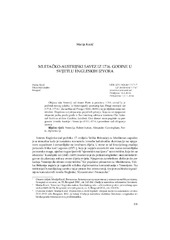Приказ основних података о документу
Mletačko-austrijski savez iz 1716. godine u svjetlu engleskih izvora
The Veneto-Austrian Alliance of 1716 in the Light of English Sources
| dc.creator | Kocić, Marija | |
| dc.date.accessioned | 2023-09-25T13:43:28Z | |
| dc.date.available | 2023-09-25T13:43:28Z | |
| dc.date.issued | 2014 | |
| dc.identifier.issn | 1330-7134 | |
| dc.identifier.uri | http://reff.f.bg.ac.rs/handle/123456789/4895 | |
| dc.description.abstract | Objava rata Veneciji od strane Porte u prosincu 1714. označila je početak novog sukoba, u historiografiji poznatog kao Drugi morejski rat (1714.-1718.). Za razliku od Prvoga (1684.-1699.), taj je dijelom ostao neistražen. Doprinos razjašnjavanju pojedinih pitanja, koja su se njegovom objavom javila, pruža građa iz Nacionalnog arhiva u Londonu (The National Archives at Kew Gardens, London). Ona donosi nove poglede na pregovore između Austrije i Venecije (1715.-1716.) povedene radi sklapanja saveza. | sr |
| dc.description.abstract | The alliance concluded on 13 April 1716 in Vienna represented the highest peak of the efforts of both Venetian and papal diplomacy to drag Austria into the new war with the Ottoman Empire. Some contemporaries and the contemporary press, which had just became an important means of disseminating and receiving information in “Classical” Europe, had anticipated that step since the moment when Venice found itself alone in the struggle with the powerful, even though visibly weakened, Ottoman state. The experience of the creation of the previous Holy League of 1683-1684 was still alive, but a new constellation of relations in Europe influenced a change of the side that played the role of its initiator. This time, it was Venice that, together with the papacy, influenced Emperor Charles VI, encouraging him to enter into a new military adventure with uncertain results. British diplomats in Venice, Alexander Cunningham (with the title of resident), and Constantinople, Robert Sutton (ambassador), became witnesses of political contest and a number of problems that were created by the initial idea of the creation of that alliance. Even though they resided on territories of opposed sides, they both presented their views on the negotiations, in a form as accurate as could be when their diplomatic authority allowed them to obtain information or the means at their disposal allowed them to buy it. In their reports, which are sometimes contradictory to the views expressed in the press, they describe the course of the negotiations. Precisely for this reason, these reports are important historical sources, partially explaining the “turning point” on which Vienna stood by the decision to enter into the new war with the Ottoman Empire. | sr |
| dc.language.iso | hr | sr |
| dc.publisher | Zavod za povijesne i društvene znanosti HAZU, Zagreb | sr |
| dc.rights | openAccess | sr |
| dc.rights.uri | https://creativecommons.org/licenses/by/4.0/ | |
| dc.source | Zbornik Odsjeka za povijesne znanosti Zavoda za povijesne i društvene znanosti HAZU | sr |
| dc.subject | Venecija | sr |
| dc.subject | Robert Sutton | sr |
| dc.subject | Alexander Cunningham | sr |
| dc.subject | Porta | sr |
| dc.subject | diplomacija | sr |
| dc.subject | Venice | sr |
| dc.subject | the Porte | sr |
| dc.subject | diplomacy | sr |
| dc.title | Mletačko-austrijski savez iz 1716. godine u svjetlu engleskih izvora | sr |
| dc.title | The Veneto-Austrian Alliance of 1716 in the Light of English Sources | sr |
| dc.type | article | sr |
| dc.rights.license | BY | sr |
| dc.citation.epage | 147 | |
| dc.citation.rank | M22 | |
| dc.citation.spage | 131 | |
| dc.citation.volume | 32 | |
| dc.identifier.fulltext | http://reff.f.bg.ac.rs/bitstream/id/11965/bitstream_11965.pdf | |
| dc.identifier.rcub | https://hdl.handle.net/21.15107/rcub_reff_4895 | |
| dc.type.version | publishedVersion | sr |

